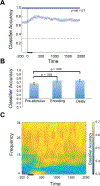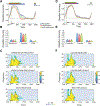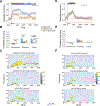The time course of encoding and maintenance of task-relevant versus irrelevant object features in working memory
- PMID: 30508678
- PMCID: PMC6358497
- DOI: 10.1016/j.cortex.2018.10.013
The time course of encoding and maintenance of task-relevant versus irrelevant object features in working memory
Abstract
Access to WM can be restricted on the basis of goal-relevant properties such as spatial location. However, the extent of voluntary control over which features of an attended multi-feature object are encoded and maintained in WM is debated. Some evidence suggests that attending to an object leads to obligatory storage of all of its features, whereas other evidence suggests that access to WM can be restricted to only goal-relevant features. Another possibility is that all features are initially encoded, but irrelevant features are removed from WM over time. To address these various possibilities, we used pattern classification of EEG signals to track the temporal evolution of representations reflecting the encoding and storage of task-relevant and irrelevant features in WM. In different blocks, participants remembered the orientation, color or both orientation and color of a colored, oriented grating. The color and orientation of the grating was randomly drawn from two distinct feature bins on each trial. To examine trial-specific activity reflecting storage of the object's features, a support vector machine (SVM) classifier was trained to classify what bin the stimulus features came from. Importantly, for orientation, the classifier produced reliably above-chance classification across the delay when orientation was task-relevant but not when it was task-irrelevant. Interestingly, orientation could be accurately classified on trials for which both orientation and color were remembered. Moreover, a separate measure corresponding to the probability of a feature belonging to the correct bin was significantly higher when orientation was task-relevant compared to task-irrelevant during encoding. Above-chance classification for color was only present during the initial 500 msec across all conditions. Our results suggest that although information about all of an object's features is present in the initial stimulus-evoked neural response, information about the task-irrelevant features is attenuated during stimulus encoding and is largely absent throughout the delay.
Keywords: Feature binding; Support-vector machine classifier; Top-down control; Working memory.
Copyright © 2018 Elsevier Ltd. All rights reserved.
Conflict of interest statement
The authors declare no conflict of interest.
Figures





References
-
- Baddeley AD, & Hitch GJ (1974). Working Memory. In Bower GH (Ed.), The psychology of Learning and Motivation (pp. 47–90). New York: Academic Press.
-
- Brainard DH (1997). The psychophysics toolbox. Spatial Vision, 10, 433–436. - PubMed
-
- Chang C-C, & Lin C-J (2011). LIBSVM: A library for support vector machines. ACM Transactions on Intelligent Systems and Technology, 2(3), 1–27. 10.1145/1961189.1961199 - DOI
Publication types
MeSH terms
Grants and funding
LinkOut - more resources
Full Text Sources

